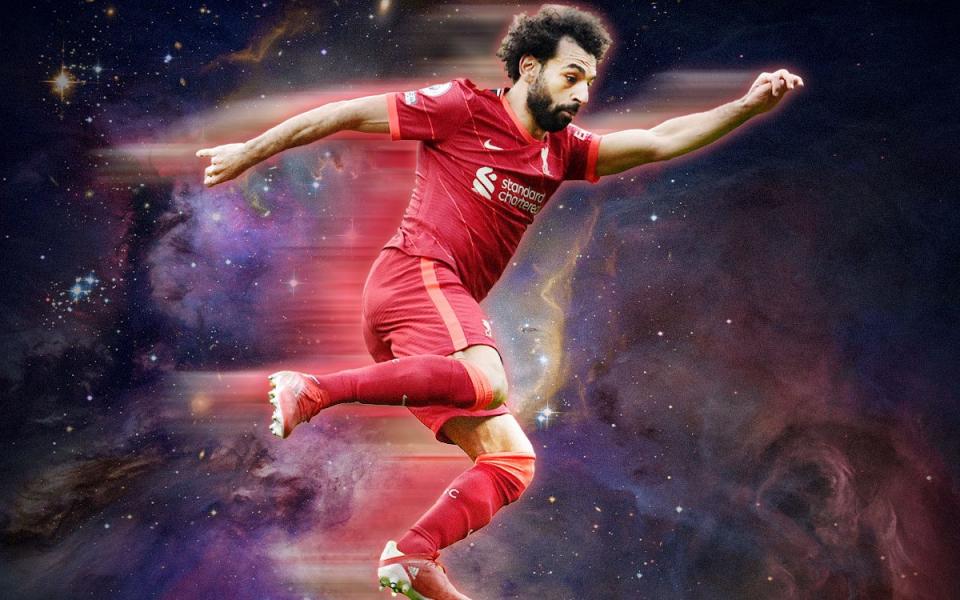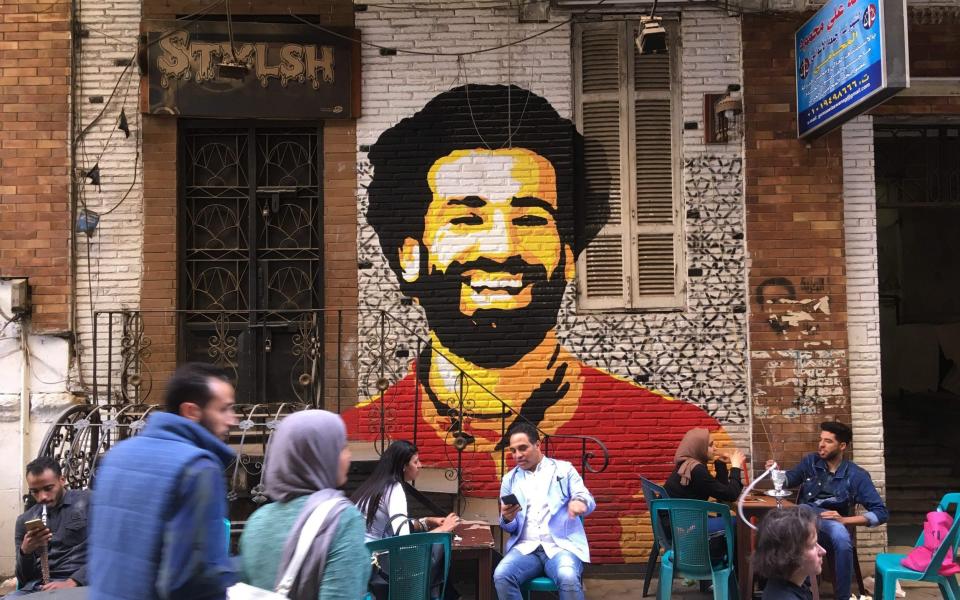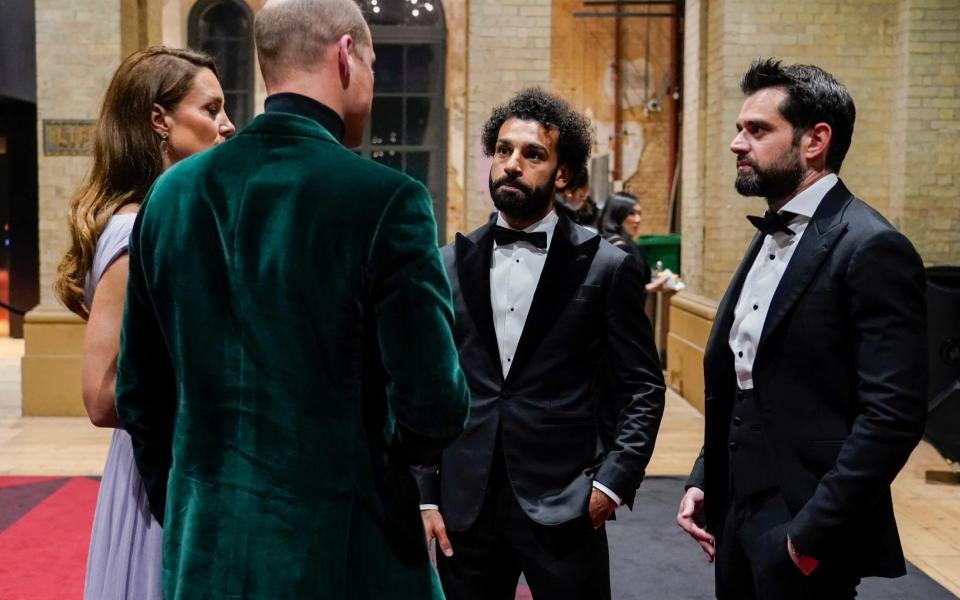Mohamed Salah: How he became the world's best footballer

Place the ideal player in the perfect environment, working under an exceptional coach, and you facilitate the extraordinary rise of Mohamed Salah into a footballing tour de force – and arguably the world's best player.
Salah arrived at Liverpool in 2017 with plenty to prove after a brief and unhappy stint in the Premier League at Chelsea. At Old Trafford on Sunday, he added another hat-trick to his collection, and has been tipped as the next Ballon d’Or winner, heir apparent to Cristiano Ronaldo and Lionel Messi as one of the most gifted and marketable players of his generation. Telegraph Sport analyses the challenges Salah has overcome to get there – and how he has been transformed from a player of potential to arguably the world’s best.
Moving into another goal-scoring orbit
Let’s start with Sergio Ramos in Kiev in 2018 – not with the incendiary challenge that dislocated Salah’s shoulder and prematurely ended the forward’s first Champions League final. Instead, rewind 24 hours and Ramos's pre-match press conference, when the Spaniard was asked if Salah's 44-goal debut season at Anfield put him on the same pedestal as Ronaldo and Messi.
“Comparing players with Ronaldo and Messi is something you can't do,” he said. “They're in another orbit. There are players who are in fashion, those who come and go and others who stay around.”
He was right – world-class status cannot be afforded for one freakishly brilliant campaign. But after four years and 137 Liverpool goals, Salah has long since ridiculed any accusations of being a ‘one-season wonder’.
When he joined from Roma, there was no sense he would be a natural goal-scoring successor to Ian Rush, Roger Hunt, and Robbie Fowler, even if he had asked to work with a specialist finishing coach in Italy to capitalise on the chances his pace created.
But at Liverpool the plan radically changed after a few training sessions, the ‘left winger’ moved to the right where he could cut inside.
“He played more on the wing for Roma, where he had a very dominant striker in Edin Dzeko,” Klopp explained. “We didn’t know exactly that he’s capable of playing in the centre. Nobody could know. We learned it step-by-step.”
Today, the Egyptian is scoring at a faster rate than his 44-goal campaign – every 80 minutes in 2021-22 when it was every 94 minutes in 2017-18. He is having more shots on target per match than any other time in his career. In scoring against Manchester United he overtook Didier Drogba’s record of 104 goals in the Premier League for an African player and will have done so in 85 fewer games (167).
Nobody can eclipse Messi and Ronaldo’s numbers season upon season. But of the pretenders to the title of ‘world’s best’, Salah’s goal and assist rate put him alongside Robert Lewandowski, Karim Benzema and Erling Haaland in terms of staggering consistency, while the kinds of goals he is scoring – particularly the recent strikes against Manchester City and Watford – simply add depth to the Messi comparisons.
It is also when he scores which matters – like all the true greats, he tends to reserve his best for the elite opponents. In games against other members of the self-styled ‘Big Six’ prior to Old Trafford on Sunday, Salah had 32 goals in 63 games, with 10 assists. It equates to a goal every 159 minutes. In comparison Ronaldo has played 79 games with 28 goals and 14 assists at a goal every 228 minutes.
Throw in major goals in the Champions League (he is already Liverpool's top scorer in the competition) and it becomes clear this is a man for the big occasion.
Creating more than ever
It is August 2019 and Liverpool are comfortably beating Burnley. Salah dashes to goal with two options; a simple pass to Sadio Mane for a tap-in, or try to score himself.
He chooses the latter and misses, prompting a furious reaction from Mane, who has still not calmed down when he is substituted a few minutes later.
Salah and Mane laughed off the incident in the Turf Moor dressing room, but it still sparked a forensic examination of their relationship, with every missed opportunity to pass to each other being micro-analysed.
That season represented something of a nadir in terms of Salah creating chances for Mane, but those numbers have shot up over the last two campaigns, with last weekend’s perfectly-executed assist at Watford, delivered with the outside of his left foot, maintaining that trajectory.
More generally, Salah's creativity has hit new heights this season: he is making, on average, 2.34 chances per game – his best ever return at Anfield – and already has four assists, just two shy of his tally in 2020-21.
Accusations of being ‘too selfish’ have dissipated, Salah’s decision-making reflective of his greater maturity and experience.
His physical condition
Klopp may have been open-mouthed when Salah danced his way past the Manchester City defence in the recent 2-2 draw, but his most vociferous applause came for a seemingly more mundane move.
It came when Phil Foden was terrorising makeshift right-back James Milner, easing towards a shooting position, only for Salah to chase back 40 yards to retrieve possession.
Klopp’s assistant Peter Krawietz hails the “passion” in Salah’s defending, but the basis of that kind of work-rate is primarily physiological and Salah’s physical condition has been transformed. He is a disciple of club nutritionist Mona Nemmer, while some of his closest confidantes at Anfield have been the conditioning coaches led by Andreas Kornmayer, who was recruited from Bayern Munich.
Salah was not shy of removing his jersey to exhibit his six-pack after one of his most celebrated goals against Manchester United at Anfield in 2020, and he did the same after scoring against Crystal Palace in September.
His sculpted torso is a result of nutrition – more protein and carbohydrates for a player who is naturally lean – and a training programme to gain core strength. With his ‘flex’ and waxed chest, Ronaldo has clearly been an influence and Salah is also renowned for his professionalism.
He arrives early for training and gym work – those at Liverpool joke that his car is always at the training ground – and is committed to recovering, mobility and strength sessions. He rarely misses a game – just seven of the 159 Premier League matches since he joined Liverpool – and his robustness is one of his stand-out attributes. He is always able to play.
The “Never Give Up” psychology
It was on the night of Liverpool’s famous comeback against Barcelona in the Champions League semi-final, incredibly overcoming a 3-0 first leg deficit at Anfield in May 2019, that Salah, who was ruled out of the game after suffering concussion, wore a T-shirt emblazoned with the words: Never Give Up.

It is a phrase that could apply to his life story given the scarcity of Egyptian players becoming footballing megastars in Europe. Before Salah the player who had risen furthest was Mido, who played for Ajax and Tottenham and claimed to have recommended Salah to the north London club.
In a sense Salah remains the boy from Basyoun, who made a daily eight-hour round trip from his village, Nagrig, to train in Cairo, having initially been overlooked by scouts. He never lost that desire to prove himself, and it helps explain his motivation in coming back to the Premier League after his time at Chelsea. Salah’s wild celebration in scoring for Fiorentina against Tottenham in the Europa League in 2015 was a sign of that – this was a man who wanted to show England what he can do. Maybe it is also why he chose Liverpool, who were out-bid for Salah by Chelsea in 2014.
Salah is highly intelligent, with a hunger for knowledge and new experiences. He once said that moving to Europe opened his eyes to "the difference in everything – from standard of living to food, to communication” and he has embraced life in every new country he has sampled. He learned English during his time in Switzerland, and thrived in Italy. “The biggest thing that helped me throughout my career is that I always want to learn,” he has said.
Why his time at Chelsea did not work out is up for debate. Former team-mate Filipe Luis, who also did not last long before returning to Spain, has his own theory.
“When he went to Fiorentina I said: ‘Why are you going, Momo? This is Chelsea.'" he recalled. "And he said: ‘I need to play’. I thought: ‘This kid’s good’. He never went for money or to win more: he went to show he could play. In training he was like Messi. Really, like Messi. Ask anyone.”
Jose Mourinho, Chelsea's manager at the time, strongly disputes not wanting Salah. In fact he claims it was his idea to sign him in the first place, on the back of his performances against Chelsea, and it was the club who sold him.
However, tellingly, he also said: “He was just a lost kid in London. He was a lost kid in a new world”, while Eddie Newton, Chelsea’s former loan manager, claimed there was a “personality clash” between manager and player. Either way, it left Salah even more determined.
Cultivating his image
Salah has been represented like a megastar long before he established himself as one, and his general inaccessibility at Liverpool – he rarely speaks to English media – has added to the aura around him.

His most trusted advisor, Ramy Abbas, has managed his image carefully, and when he does speak, the outlets tend to be pointed: he has given major interviews to CNN (he is sufficiently popular in the US to warrant a graffiti mural of him in New York’s Times Square) and Spanish newspapers, most recently Marca in April, which fuelled suggestions he was courting interest from Real Madrid.
His social media is also choreographed – he posts regularly, but never controversially – and his family members are under strict instructions not to speak to journalists.
There is shrewdness to his PR given how many celebrity events he must be invited to. Last weekend, Salah was among the notable guests at Prince William’s Earthshot awards, maintaining the player’s image as a humanitarian beyond the pitch.


Does this matter? It helps when the image is backed up with substance. Salah has contributed millions to charity as part of the Egyptian foundation set up in his name and which is managed by his father, uncle and brother. In Nagrig there are projects everywhere funded by Salah, including a girls’ school and a building for the ambulance services. Four hundred families receive direct assistance from the foundation that also helps Syrian refugees and even funds marriages.
“He is a role model in so many different ways,” says Klopp. “It’s really, really nice to have him, not only him but Sadio as well. They are both Muslims and they live in a world where these things are so often discussed in a dangerous manner, where we think they are all like this or all like that.
“We know it’s not true but it’s nice to have someone around who is full of joy, full of love doing what he’s doing.”
There is still the issue of Salah's contract to resolve, given it runs out at the end of next season. Liverpool are desperate for the 29-year-old to stay, and will have been heartened by his comments on Friday that he hopes to end his career at the club, but a deal is still some way off.
It will be whether he can fulfil his ambitions at Liverpool that might determine his long-term future; for the time being, Anfield – and English football – should simply enjoy what they have.

 Yahoo Sport
Yahoo Sport 





































